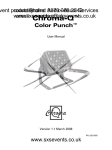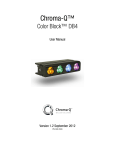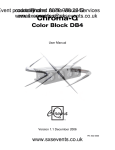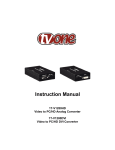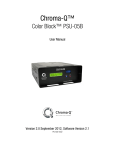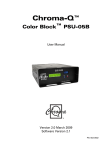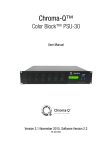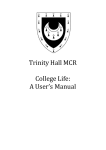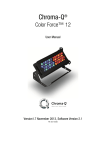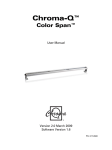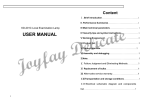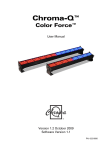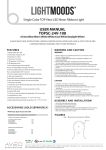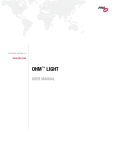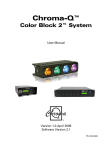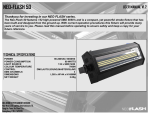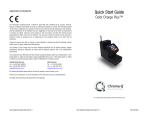Download CHCS2 - Chroma-Q
Transcript
Chroma-Q™ Color Split™ User Manual Version 1.3 September 2007 Software Version 4.0 PN: 609-0500 Disclaimer The information contained herein is offered in good faith and is believed to be accurate. However, because conditions and methods of use of our products are beyond our control, this information should not be used in substitution for customer's tests to ensure that Chroma-Q products are safe, effective, and fully satisfactory for the intended end use. Suggestions of use shall not be taken as inducements to infringe any patent. Chroma-Q sole warranty is that the product will meet the sales specifications in effect at the time of shipment. Your exclusive remedy for breach of such warranty is limited to refund of purchase price or replacement of any product shown to be other than as warranted. Chroma-Q reserves the right to change or make alteration to devices and their functionality without notice due to our on going research and development. The Chroma-Q Color Split has been designed specifically for the professional entertainment lighting industry. Regular maintenance should be performed to ensure that the products perform well in the entertainment environment. If you experience any difficulties with any Chroma-Q products please contact your selling dealer. If your selling dealer is unable to help please contact [email protected]. If the selling dealer is unable to satisfy your servicing needs, please contact the following, for full factory service: Outside North America: Tel: +44 (0)1494 446000 Fax: +44 (0)1494 461024 [email protected] North America: Tel: 416-255-9494 Fax: 416-255-3514 [email protected] For further information please visit the Chroma-Q website at www.chroma-q.com. Chroma-Q is a trademark, for more information on this visit www.chroma-q.com/trademarks. The rights and ownership of all trademarks are recognised. Color Split User Manual 1 V1.3 September 2007 Table of Contents 1. Product Overview ……………………..………………..…………….………........... 3 2. Operation ……………...…………………………………..…………………….…….. 3 2.1 Unpacking the unit ………………………………..………..………………… 3 2.2 Control and power cables ………………………..………..………………… 4 2.3 Diffusion Film ………………………………………………………………….. 5 2.4 Fixing ………………………………………..…………………………………. 5 2.5 Operating the unit ………………………………………..………………….. 6 2.6 Modes of operation ………………………………………………………….. 7 2.7 Technical specifications ………………………………………………….… 10 2.8 Maintenance …………………………………………………………………. 10 2.9 Accessories ………………………………………………………………….. 11 3. 3.1 Drawings …………………………………………………………………………….. 11 Outside dimensions ………………….…………………………………………….. 11 Color Split User Manual 2 V1.3 September 2007 1. Product overview The Chroma-Q Color Split lighting fixture is designed specifically for professional entertainment lighting. The fixture’s modular design shall be suitable for creating a wide range of fixture configurations, including battens, blinders, footlights, side fills, cyclorama floods, truss toners, discreet set piece lighting and interior architectural lighting. Each Color Split fixture features 32 high power LEDs split into two cells which produce intense, powerful light and vibrant colours across the across the spectrum. A 5 degree diffusion film is integrated into one cell and a 20 degree diffusion film is integrated into the other cell. A range of optical accessories are available to increase the flexibility of the fixture. Various diffusers can be utilised to adjust projected beam angles and create stunning visual effects. Designed to be intelligent both inside and out, the modular blocks incorporate the latest Hue, Saturation and Intensity (HSI), RGB(A) with Magic amber, RGBA control modes. Variable Effects Engine is integrated in the software which gives the lighting designer full control over colour and effects combinations. The products lightweight yet robust, heavy gauge aluminium extruded construction houses a discreet cable management system and additional protection is built around the LED lenses for a truly road proof fixture. The Color Split has a built-in power supply with power input and through via PowerCon. The unit can be controlled remotely through ANSI E1.11 USITT DMX 512-A. 2. 2.1 2.2 2.3 2.4 2.5 2.6 2.7 2.8 2.9 Operation Unpacking the Unit Control and Power Cables Diffusion Film Fixing Operating the Unit Modes of Operation Technical Specifications Maintenance Accessories 2.1 Unpacking the unit The Color Split package includes 1 unit Color Split fixture, 1 unit yoke, 2 pieces M10 x 16 knobs, 2 pieces fibre flat washers and 1 piece M10 flat washer. Color Split User Manual 3 V1.3 September 2007 2.2 Control and Power Cables The Color Split utilises a PowerCon cable system for power input and through and the XLR 5pin cable system for ANSI E1.11 USITT DMX 512-A data signal input and through. The XLR 5pin cables are wired pin to pin in the format shown in the table below. The chassis are ground bonded. XLR 5-pin cable: Pin # 1 2 3 4 5 Power cable: International Colour Code Green and Yellow Blue Brown Function Ground (-ve) Control data minus (-) Control data plus (+) Spare data minus Spare data plus North American Colour Code Green White Black Minimum Cable size Screen 0.35mm² (22 AWG) 0.35mm² (22 AWG) 0.35mm² (22 AWG) 0.35mm² (22 AWG) Connections Earth (E) Neutral (N) Live (L) Ground (Green) Neutral (Silver) Hot (Gold) Important Notice: The use of an opto-splitter for DMX signal distribution is highly recommended when several fixture units are not plugged into the same power source. It is recommended that a maximum of 10 Color Split fixtures can be linked together utilising the power input and through connections; data input and through connections as shown in the illustration below. Data Input Data Through Power Input Power Through Important Notice: The use of an opto-splitter for DMX signal distribution is highly recommended when several fixture units are not plugged into the same power source. Color Split User Manual 4 V1.3 September 2007 2.3 Diffusion Film The Color Split has a 5 degree diffusion film integrated into one cell and a 20 degree diffusion film integrated into the other cell. Printed at the bottom plate are “chevrons” that indicate the side with the 20 degree diffusion film. 5° Diffusion Film on this side 20° Diffusion Film on this side 2.4 Fixing The Color Split is supplied with a detachable yoke for a single fixture which can be used for floor mounting, direct wall mounting and truss mounting. The Color Split features an integral connection system to enable up to 3 units locked together as a batten or strip. Integral M10 clinch nuts are built into each end of the fixture which can be used to attach the fixture to a standard hook clamp or the wide range of Color Split mounting accessories. Note: • For the M10 nuts, ensure that the bolt is not too long to avoid damage. • Secure each fixture with the safety bond. Provision for a fixing hold is built into the end plate of each fixture for secondary fixings. • Ensure adequate ventilation to the rear of all Color Split fixtures. Avoid placing the fixtures directly on the floor pointing upwards which leaves very little space for ventilation. Integrated Connection System One end plate of the Color Split fixture features two protruding locating pins and a catch plate, and the other end plate of each fixture has two keyhole slots and a butterfly latch. 1. To connect two fixtures together, firstly mate the four protruding pins from one fixture into the keyhole slots of the other fixture. 2. Then slide the fixtures together so that they are aligned correctly, taking care to get past the extended catch plate. Note: This will be stiff on new fixtures and a twisting action may ease assembly. Color Split User Manual 5 V1.3 September 2007 3. Finally, use the butterfly latch to secure the fixtures together tightly (maximum of 3 units together). Yoke Kit The Color Split fixture is supplied with a detachable yoke kit for a single fixture with fibre washers and thumb wheels. An M10 flat washer is provided as a spacer for the side with protruding pins. The yoke kit can be used for floor mounting, direct wall mounting and truss mounting when used with hook clamps or half couplers. Note: See Drawing on page 12. 2.5 Operating the Unit The Color Split is controlled via a built-in addressable ANSI E1.11 USITT DMX 512-A power supply. Control functions are accessed through the LCD display at the rear plate with 3 pushbutton switches. Push button operation: Control Red Button Black Button Blue Button 3 digit display Function Mode access, enter and record Down - Decreases (-) the mode level or value Up - Increases (+) the mode level or value Displays mode, monitor or blank display Display operation: Power-Up Display On power-up, the display shows the software version ‘u04’ and the DMX address. Monitor Display If control buttons are left undisturbed for 5-7 seconds, the display will revert to ‘Monitor Mode’ The first vertical bar indicates that there is DC power unit. The second vertical bar indicates that there is Data (DMX). The horizontal bars indicate the Data Signal Level of first DMX channel: 0 - 24% No bars 25 – 49% 1 Bar 50 – 74% 2 Bars 75 – 100% 3 Bars Display Mode The display can be set to auto-blackout 5 seconds after it goes to ‘Monitor Mode’. Press ENTER (red) and UP (blue) or DOWN (black) buttons to select ‘dP’ mode, then select ‘dp1’ to turn ON the auto-blackout or ‘dP0’ to turn OFF the auto-blackout. Default Settings: 'Factory' default settings Reset Press and hold for 1 second, the UP (blue) and DOWN (black) buttons to reset the unit to the factory default settings. The display will show ‘rSt’ when UP and DOWN buttons are pressed and after 1 second it changes to ‘don’. Color Split User Manual 6 V1.3 September 2007 The Factory default settings put the unit in its normal operating mode. DMX Address = 001 Display = dP0 Mode = oP1 Effects = F05, c26 'User' default settings Each time the RED record button is pressed, the unit will save that change and these 'user defaults' will take precedence on the next power cycle. 2.6 Modes of operation The Color Split fixture features 32 high power LEDs divided into 2 separate cells of 16 LEDs each. The LEDs in both cells can be controlled together as one (single control) and individually as two separate cells (dual control). Note: *Magic Amber is the term used for the unit's ability to be controlled with 3 channels and include Amber when mixing the colours. a. Control Modes Mode 1 ‘oP1’: Single control (for 2 cells x 16 LEDs) in 3 channel RGB(A) (with *Magic Amber) is the traditional way of controlling intensity channels of the fixture. Each of the 3 control channels directly affects the intensity of the corresponding LED – Red, Green and Blue (with Magic amber). Colour is mixed by adjusting the levels of the three primary colours. White is achieved with all channels at full. Mode 2 ‘oP2’: Single control (for 2 cells x 16 LEDs) in 4 channel RGBA: gives 4 control channels directly affecting the intensity of the corresponding LED – Red, Green, Blue and Amber. Colour is mixed by adjusting the levels of each of the four colours. White is achieved with all channels at full. Mode 3 ‘oP3’: Single control (for 2 cells x 16 LEDs) in 3 channel HSI (Hue, Saturation and Intensity) and 2 channels for Effects: gives 2 colour channels for hue and saturation, 1 separate intensity channel, 1 channel for colour roll speed and 1 channel for colour range. A separate definable intensity channel is particularly useful when creating intensity chases or when the grand master is used. The hue channel has 255 different colours available and the saturation channel specifies the saturation level of that colour. The saturation channel is fully saturated at full. White is achieved with the intensity channel to full and the saturation channel at zero. Colour Roll Speed: 0% - Off; 100% - Fastest Colour Range: 0% - Full Colour Spectrum; 67% - 1/3 Colour Spectrum Mode 4 ‘oP4’: Single control (for 2 cells x 16 LEDs) in 3 channel RGB(A) (with *Magic Amber), 1 channel for Master Intensity and 1 channels for Effects: gives 3 control channels directly affecting the intensity of the corresponding LED – Red, Green, Blue (with Magic Amber), 1 channel for intensity effects and 1 channel for master intensity control. The first channel sets intensity effect and speed: 0-24% fade on/fade off 25-49% fade on/snap off 50-74% snap on/fade off 75-100% strobe Mode 5 ‘oP5’: Dual control (for 2 cells x 16 LEDs) in 6 channel RGB(A) (with *Magic Amber): gives 2 sets of the 3 control channels for each cell directly affecting the intensity of the corresponding LEDs – Red, Green and Blue (with Magic amber). Colour is mixed by adjusting the levels of the three primary colours. White is achieved with all channels at full. Mode 6 ‘oP6’: Dual control (for 2 cells x 16 LEDs) in 8 channel RGBA: gives 2 sets of 4 control channels for each cell directly affecting the intensity of the corresponding LED – Red, Green, Blue and Amber. Colour is mixed by adjusting the levels of each of the four colours. White is achieved with all channels at full. Color Split User Manual 7 V1.3 September 2007 Mode 7 ‘oP7’: Dual control (for 2 cells x 16 LEDs) in 6 channel HSI and 2 channel for Effects: gives 2 sets of 2 colour channels for hue and saturation, 2 sets of separate intensity channels, 1 channel for colour roll speed and 1 channel for colour range. Colour Roll Speed: 0% - Off; 100% - Fastest Colour Range: 0% - Full Colour Spectrum; 67% - 1/3 Colour Spectrum In this mode, various split colour wave effects can be created within a selected range of colours. Set DMX-Ch2 @ any value greater than 0, and set DMX-Ch3 @ 0 or greater than DMX-Ch6 to create two cells rolling in the opposite direction and therefore creating colour waves in the assigned range of colours. Example: To create a blue to green wave effect: set DMX-Ch2 @ 67%, DMX-Ch3 @ 0%, and DMX-Ch6 @ 33%, set desired speed on DMX-Ch1 and set DMX-Ch4, Ch5, Ch6, Ch7,Ch8 @ 100%. Mode 8 ‘oP8’: Dual control (for 2 cells x 16 LEDs) in 6 channel RGB(A) (with ∗Magic Amber), 2 channel for Master Intensity and 1 channels for effects: gives 2 sets of 3 control channels directly affecting the intensity of the corresponding LED – Red, Green, Blue (with Magic amber), 1 channel for intensity effects and 2 channels for master intensity control. The first channel sets intensity effect and speed: 0-24% fade on/fade off 25-49% fade on/snap off 50-74% snap on/fade off 75-100% strobe and speed Mode 9 ‘oP9’: Stand-alone provides ‘F00 –F99’ steps for variable selection of pre-programmed effects. The ‘F’ setting is accessible only in ‘oP9’. ‘F00-F09’ 10 speeds full colour roll ‘F10-F19’ 10 speeds cold colour roll ‘F20-F29’ 10 speeds warm colour roll ‘F30-F39’ 10 speeds magenta colour roll ‘F40-F45’ 6 fixed split colours ‘F46-F69’ 24 fixed solid colours, 4 levels of saturation for each colour: blue, cyan, green, yellow, red and magenta ‘F70-F79’ 10 fixed white colours: 2600K, 3200K, 3600K, 4100K, 5000K, 5600K, 6500K, 7000K, 7500K, 8000K ‘F80-F84’ 5 speeds fade on/fade off ‘F85-F89’ 5 speeds fade on/snap off ‘F90-F94’ 5 speeds snap on/fade off ‘F95-F99’ 5 speeds strobe Colour Selection of intensity effects ‘c00 to c29’ is accessed when value is between F80 – F99. Note: In this mode, the DMX level indicator stays off. Demo Mode ‘oP-’: is a pre-programmed sequence of the following (5 seconds for each interval): Start with 3 solid colours: cyan, yellow and magenta; 3 split colours are added; Partial colour rolls start from the split colours; Full colour roll; Cold colour roll; Warm colour roll; Fade on/fade off; Fade on/snap off; Medium strobe; Fast strobe. Note: In this mode, the DMX level indicator stays off. Color Split User Manual 8 V1.3 September 2007 b. Control Menu Note: Press the ENTER (red) and UP (blue) or DOWN (black) button to move between modes and press ENTER to record any changes made. Mode Display Name 1 oP1 RGBhA Cell Control Single 2 oP2 RGBA Single 4 3 oP3 HSIfx Single 5 4 oP4 RGBhAI Single 5 5 oP5 RGBhA Dual 6 6 oP6 RGBA Dual 8 7 oP7 HSIfx Dual 8 8 oP8 RGBhAI Dual 9 Color Split User Manual DMX Ch 3 9 Channels Channel 1 = Red Channel 2 = Green Channel 3 = Blue Channel 1 = Red Channel 2 = Green Channel 3 = Blue Channel 4 = Amber Channel 1 = Colour Roll Speed Channel 2 = Colour Range Channel 3 = Hue Channel 4 = Saturation Channel 5 = Intensity Channel 1 = Intensity Effects and Speed Channel 2 = Red Channel 3 = Green Channel 4 = Blue Channel 5 = Master Intensity Channel 1 = Red 1 Channel 2 = Green 1 Channel 3 = Blue 1 Channel 4 = Red 2 Channel 5 = Green 2 Channel 6 = Blue 2 Channel 1 = Red 1 Channel 2 = Green 1 Channel 3 = Blue 1 Channel 4 = Amber 1 Channel 5 = Red 2 Channel 6 = Green 2 Channel 7 = Blue 2 Channel 8 = Amber 2 Channel 1 = Colour Roll Speed Channel 2 = Colour Range Channel 3 = Hue 1 Channel 4 = Saturation 1 Channel 5 = Intensity 1 Channel 6 = Hue 2 Channel 7 = Saturation 2 Channel 8 = Intensity 2 Channel 1 = Intensity Effects and Speed Channel 2 = Red 1 Channel 3 = Green 1 Channel 4 = Blue 1 Channel 5 = Master Intensity 1 Channel 6 = Red 2 Channel 7 = Green 2 Channel 8 = Blue 2 Channel 9 = Master Intensity 2 V1.3 September 2007 9 oP9 10 oP- Stand-Alone Press ENTER to access ‘F00-F99’ steps; press UP (blue) or DOWN (black) button to move between steps and press Enter to record any changes made. The F setting is accessible only in ‘oP9’. ‘F00-F09’ 10 speeds full colour roll ‘F10-F19’ 10 speeds cold colour roll ‘F20-F29’ 10 speeds warm colour roll ‘F30-F39’ 10 speeds magenta colour roll ‘F40-F45’ 6 fixed split colours ‘F46-F69’ 24 fixed solid colours, 4 levels of saturation for each colour: blue, cyan, green, yellow, red and magenta ‘F70-F79’ 10 fixed white colours: 2600K, 3200K, 3600K, 4100K, 5000K, 5600K, 6500K, 7000K, 7500K, 8000K ‘F80-F84’ 5 speeds fade on/fade off ‘F85-F89’ 5 speeds fade on/snap off ‘F90-F94’ 5 speeds snap on/fade off ‘F95-F99’ 5 speeds strobe Press ENTER when in between values F80-F99 to access Colour Selection of intensity effects ‘c00 to c29’; and UP (blue) or DOWN (black) button to move between colours and press Enter to record any changes made. Demo Mode Note: The DMX level indicator stays off in modes ‘oP9’ and ‘oP-’. 2.7 Technical specifications Dimensions: 250mm x 136mm x 125mm 9.8” x 5.3” x 4.9” Weight: 2.38kg / 5.25 lbs DMX protocol: ANSI E1.11 USITT DMX 512-A Working Voltage: 90 – 240V AC Power consumption: 60W Connectors: XLR5 in/thru, PowerCon in/thru Body material: Aluminum extrusion Body colour: Black anodised Cooling: 1 x fan European approvals: Pending North American approvals: Pending 2.8 Maintenance With care, the Color Split fixture will require little maintenance. However, as the unit is likely to be used in a stage environment we recommend periodical internal inspection and cleaning of any resulting dust and cracked oil residue. Do not spray liquids on the front or rear panel. If the front enclosure requires cleaning, wipe with a mild detergent on a damp cloth. Color Split User Manual 10 V1.3 September 2007 2.9 Accessories CHCBBK20 CHCBBK30 CHCBBK3005 CHCBBK6010 3. 20 degree beam kit for Color Block/Split 30 degree beam kit for Color Block/Split 30 x 5 degree beam kit for Color Block/Split 60 x 10 degree beam kit for Color Block/Split Drawings 3.1 Outside dimensions 250mm / 9.8” 125mm / 4.9” 136mm / 5.3” Color Split User Manual 11 V1.3 September 2007















